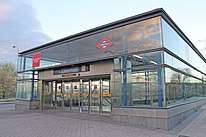Wanda Metropolitano
 | |
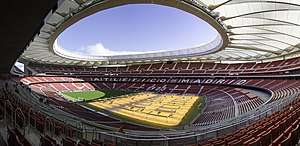 | |
| Full name | Wanda Metropolitano |
|---|---|
| Location | Madrid, Spain |
| Coordinates | 40°26′10″N 3°35′58″W / 40.43611°N 3.59944°WCoordinates: 40°26′10″N 3°35′58″W / 40.43611°N 3.59944°W |
| Public transit |
|
| Owner |
Community of Madrid (1992–2002) City of Madrid (2002–2017) Atlético Madrid (2017–present)[1] |
| Operator | Atlético Madrid |
| Capacity | 67,703 |
| Record attendance |
66,591 Atlético Madrid v Real Madrid (18 November 2017)[2] |
| Field size | 105 m × 68 m (344 ft × 223 ft) |
| Surface | Grass |
| Construction | |
| Broke ground | 1990 |
| Built | 1990–93 |
| Opened | 6 September 1994 |
| Renovated | 2017 |
| Closed | 2004 |
| Reopened | 16 September 2017 |
| Construction cost |
€ 45 million (1994) € 240 million (2017)[3] |
| Architect | Cruz y Ortiz Arquitectos |
| Main contractors | FCC |
| Tenants | |
|
Atlético Madrid (2017–present) Rayo Majadahonda (2018–present)[4] Spain national football team (selected matches) | |
Metropolitano Stadium (Spanish: Estadio Metropolitano), also referred as Wanda Metropolitano for sponsorship reasons, is a stadium in Madrid, Spain. It has been the home stadium of Atlético Madrid since the 2017–18 season. It is located in Rosas neighbourhood in the San Blas-Canillejas district.
The stadium was built as part of Madrid's unsuccessful bid to host the 1997 World Athletics Championships, and was opened on 6 September 1994 by the Community of Madrid. It was closed in 2004 due to the city's bid for the 2016 Olympics. In 2013, it passed into the possession of Atlético Madrid, who played their first game there on 16 September 2017. The stadium had a capacity of 20,000 spectators upon its closure and re-opened with a seating capacity for 67,703. It is set to host the 2019 UEFA Champions League Final.
Name
The stadium was formerly known as Estadio de la Comunidad de Madrid (Madrid Community Stadium), Estadio Olímpico de Madrid (Madrid Olympic Stadium), and more commonly by its nickname Estadio de La Peineta (The Comb Stadium). Naming rights were acquired by the Wanda Group, a Chinese company.[5] Due to UEFA sponsorship regulations the stadium is known as Estadio Metropolitano in UEFA marketing materials.[6]
History
During the early 1990s the Sports Council of the Community of Madrid promoted the city's bid to host the World Athletics Championships in 1997, and preparations began for an Olympic stadium in the east of Madrid, next to the M-40 motorway. The site was expected to be heavily urbanized.
Construction of the new stadium began in 1990 and was based on a design proposed by Cruz y Ortiz. It was completed in 1993, and the inauguration took place in September 1994. The single side tier oval shaped stadium with a capacity 20,000 seats became known as La Peineta (the comb) because of its similarity with the traditional Spanish hair comb.
The 1997 World Championships in Athletics were eventually awarded to Athens, and La Peineta was used for minor sports and cultural events during the first decade of its existence. It became an abandoned stadium in 2004.
New stadium
In 2004, the stadium was closed for a future project upon the Madrid bid for the 2016 Summer Olympics. Following the defeat of Madrid's bid in 2009, many proposals were made for the future use of the stadium. Finally, on 11 September 2013, Atlético Madrid announced their plans to build a stadium on the location of La Peineta. Thus ownership was officially transferred to the club.[7]
The new stadium replaced Vicente Calderón Stadium as Atletico's home beginning with the 2017–18 season.[3][8] On 9 December 2016, the club announced that the renovated stadium's official name would be Wanda Metropolitano[9] – Wanda for sponsorship reasons and Metropolitano due to the name of the historical stadium which hosted Atlético's matches before Vicente Calderón.[10]
It accommodates 67,703 spectators, with all spectator seats covered by a new roof[3] including 7,000 VIP, 79 VIP suites known as Neptuno Premium.[11] 4,000 car parking spaces will be available; 1,000 inside the stadium building and 3,000 outside the building.[12] As of 15 April 2017, around 48,500 season tickets had been reserved by the club fans.[13]
On 17 September 2017, the Wanda Metropolitano's inaugural event was a 2017–18 La Liga match between Atlético Madrid and Málaga CF. King Felipe VI of Spain attended and Antoine Griezmann scored the only goal.[14] On 27 September 2017, the Wanda Metropolitano hosted its first UEFA Champions League game. Chelsea beat Atlético Madrid 2–1, becoming the first English club to defeat them at home in any European club competition, and the first visiting team to win at the new stadium.[15]
Notable events
La Peineta hosted the second leg of the 1996 Supercopa de España on 28 August, with Atlético beating FC Barcelona 3–1 on the night but losing 6–5 on aggregate.[16]
During the 1997–98 Segunda División season, Madrid-based club Rayo Vallecano played some home matches at La Peineta, due to renovation works on its home ground, the Campo de Fútbol de Vallecas.[17]
On 21–22 September 2002, La Peineta hosted the 9th IAAF World Cup, an international track and field sporting event sponsored by the International Association of Athletics Federations.[18]
On 20 September 2017, shortly after the inauguration of the stadium, it was selected by UEFA to host the final match of the 2018–19 UEFA Champions League. The other selected nominee was the Baku National Stadium in Azerbaijan, which will hold the 2018-19 UEFA Europa League final.[19][20] This is the fifth European Cup/UEFA Champions League final held in Madrid, after the 1957, 1969, 1980, and 2010 finals, all held at the Santiago Bernabéu Stadium of Atlético's cross-town rival Real Madrid C.F.[21]
Spanish newspapers announced that Atlético Madrid offered Wanda Metropolitano as a permanent venue for the Copa del Rey final matches.[22]
On 27 March 2018, the ground hosted the Spain national football team for the first time for a friendly against Argentina national football team, a 6–1 win.[23]
On 21 April 2018, it hosted the 2018 Copa del Rey Final between Sevilla and Barcelona. Barcelona won the game with a final score of 5–0. During the game Andrés Iniesta was substituted under a standing ovation by the fans since it was his last final with Barcelona. [24]
Transport and access
Madrid City Council, the Ministry of Public Works and Transport and Atletico Madrid signed an agreement with the aim of building the necessary infrastructures for access to the stadium. The first phase of the works is planned to be done before the opening of the stadium, these works are the new entrance from the M-40 towards Avenida Luis Aragonés, the braiding link between the Eisenhower Knot (M-14 and M-21) and the stadium service road, and the improvement of the entrance by the Arcentales Avenue, and the construction of a second vestibule and access for the current existing Estadio Metropolitano Metro station.[25][26] These infrastructures will be paid by the club for a figure close to 30 million euros.[26]
The second will be held later, after the inauguration. The announcement from Ministry of Public Works and Transort of the opening of the O'Donnell Cercanías Madrid station, converting the existing stop -where no train makes stops- into a new station for the neighborhood of Rejas . The station would be located at the intersection of the M-21 dual carriageway and M-40 highway, close to Ciudad Pegaso and Plenilunio Shopping Center, near to the new Atletico Madrid stadium.
In the section of public transport the City Council continues in talks with the Spanish Ministry of Public Works and Transport and the Community of Madrid to continue improving access to the new stadium and adapt mobility to the substantial increase that will be submitted the neighborhood once operational the new stadium. The measures proposed by the municipality of Madrid are the request to extend line 2 of Metro to the future Cercanías Madrid station of O'Donnell, as well as the connection of said line 2 to line 7 current Estadio Metropolitano Metro station which has the largest platform of the network.[26][27]
There are three more Metro stations close to the stadium, two to 20 minutes walk: Las Rosas (line 2), Canillejas (line 5), and Las Musas (line 7), which is 10 minutes walk to the stadium.[28]
The buses actual lines of EMT Madrid with a stop close to the stadium are: 28, 38, 48, 140, 153, E2, N5 and N6; (these last two lines are nocturnal buses). Long-distance lines: 286, 288 and 289. The EMT operates a special service the match days with one line that starts from the Canillejas exchanger to the stadium (SE721 line), Canillejas has connection to Metro line 5 and EMT bus lines 77, 101, 140, 151 and 200.[28]
Construction gallery
- The comb-shaped stand, origin of the nickname of La Peineta, in March 2012
- View of the stadium during reconstruction in April 2017
- View of the stadium during the completion works in June 2017
- View of the stadium during reconstruction in June 2017
- Exterior view of the stadium in July 2017
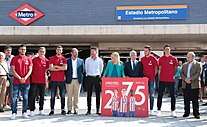 Inaguration of the new access to Estadio Metropolitano Metro station 2017
Inaguration of the new access to Estadio Metropolitano Metro station 2017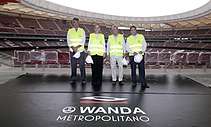 Interior of the stadium during a visit to the works in 2017.
Interior of the stadium during a visit to the works in 2017. Inner view of the stadium in August 2017
Inner view of the stadium in August 2017 Interior of the stadium from the west stand in 2017
Interior of the stadium from the west stand in 2017 Interior of the stadium during a match in 2017
Interior of the stadium during a match in 2017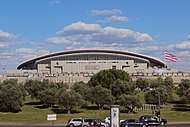 Exterior view of the stadium at the inauguration day
Exterior view of the stadium at the inauguration day
References
- ↑ "El Ayuntamiento venderá la parcela de La Peineta al Atlético". El Pais.com (in Spanish).
- ↑ "Atlético Madrid 0–0 Real Madrid". La Liga.es (in Spanish).
- 1 2 3 "Wanda Metropolitano". StadiumDB. Retrieved 1 May 2017.
- ↑ "El Wanda, la última solución para el Rayo Majadahonda" [Wanda, the last solution for Rayo Majadahonda] (in Spanish). Marca. 29 June 2018. Retrieved 1 July 2018.
- ↑ "Chinese firm Wanda to sponsor Atletico Madrid's new stadium". Reuters. Retrieved 2 October 2017.
- ↑ "Club Atlético de Madrid 2017-18 UCL matches". UEFA. Retrieved 27 August 2017.
- ↑ "El Ayuntamiento de Madrid bendice la compra de La Peineta por parte del Atlético". El Mundo.es (in Spanish).
- ↑ "Atlético Madrid's new stadium coming along a treat". AS.com.
- ↑ "Presentamos el Wanda Metropolitano". Atletico de Madrid.com (in Spa ish).
- ↑ "Atlético de Madrid". Twitter.com.
- ↑ "Premium, el nuevo concepto VIP del Wanda Metropolitano". Atletico de Madrid.com.
- ↑ "La instalación cuenta con 4.000 plazas de parking dedicadas para los días de partido". Atletico de Madrid.com.
- ↑ "Madrid: New Atletico stadium with season ticket record". Stadium DB.com.
- ↑ Lowe, Sid (18 September 2017). "A stadium called Wanda: opening night at Atlético Madrid's new home". The Guardian. Retrieved 23 September 2017.
- ↑ Henry, Matthew (27 September 2017). "Atlético Madrid 1–2 Chelsea". BBC Sport. Retrieved 2 October 2017.
- ↑ "Madrid – Estadio La Peineta / Wanda Metropolitano". 21 April 2015.
- ↑ Durán, Luis Fernando (6 September 1997). "El Rayo, desterrado a La Peineta" [The Rayo, exiled to La Peineta] (in Spanish). Madrid: El País. Retrieved 28 March 2018.
- ↑ "IAAF: Results - iaaf.org". IAAF.com.
- ↑ "Madrid to host UEFA Champions League Final 2019". UFEA.com. Union of European Football Associations. 20 September 2017. Retrieved 20 September 2017.
- ↑ "UEFA Champions League schedule (kickoff dates and times will change due to domestic competition)". UEFA.com.
- ↑ "UEFA Champions League finals". UEFA.com. 20 September 2017.
- ↑ "El Atlético ofrece el Wanda Metropolitano como sede fija para la final". Lavanguardia.com.
- ↑ Bell, Arch (27 March 2018). "Spain smash Argentina for six". Marca. Retrieved 28 March 2018.
- ↑ "Iniesta Ever Last Final With Barca".
- ↑ AS, Diario (2017-02-23). "Consulte en exclusiva los planos de la mejora de los accesos al Wanda Metropolitano | album | AS.com". AS.com (in Spanish). Retrieved 2017-06-19.
- 1 2 3 Morato, Iván. "Así serán la urbanización y los nuevos accesos al Wanda Metropolitano". Esto es Atleti (in Spanish). Retrieved 2017-06-19.
- ↑ "El Wanda Metropolitano y su gigantesca estación de Metro". abc (in Spanish). 2017-04-30. Retrieved 2017-06-20.
- 1 2 20Minutos. "Inauguración del Wanda Metropolitano: accesos y cómo llegar al estadio". 20minutos.es - Últimas Noticias (in Spanish). Retrieved 2017-10-05.
External links
| Wikimedia Commons has media related to Estadio La Peineta. |
- Gallery in the web of the club (updated)
- Official project video of the stadium
- Estadios de España (in English)
- Non-official website of the expansion works (in Spanish)
| Preceded by NSC Olimpiyskyi Stadium Kiev |
UEFA Champions League Final Venue 2019 |
Succeeded by Atatürk Olympic Stadium Istanbul |
